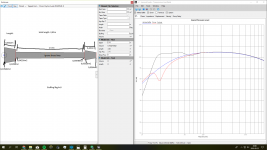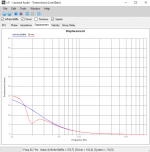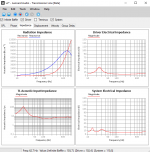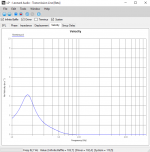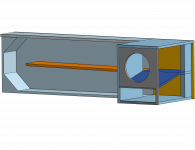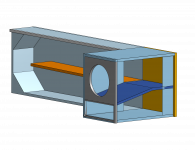Hello, I am currently in the process of designing a hide-away transmission line subwoofer using the Dayton Audio Rss265Hf-8 subwoofer and I have a few questions.
First question: How much, where and what type of stuffing should I use? In the simulation I used 9kg/m3 stuffing throughout the whole transmission line.
On the website that I plan on ordering my parts from they recommend this type of stuffing for transmission lines: Buying a Pritex 42mm? | SoundImports - SoundImports does that seem like a great choice?
Due to space limitations I am completely unable to place the subwoofer down the pipe. Does this matter too much? I understand that it would reduce the dip in SPL around 60Hz by placing it about 1 meter down the pipe, but are there any other disadvantages of not doing this? I suppose the A/V reciever would take care of that dip when calibrating?
Last, do I need to brace this enclosure in any way?
Link to subwoofer driver: Dayton Audio RSS265HF-8 10" Reference HF Subwoofer 8 Ohm
Thanks!
First question: How much, where and what type of stuffing should I use? In the simulation I used 9kg/m3 stuffing throughout the whole transmission line.
On the website that I plan on ordering my parts from they recommend this type of stuffing for transmission lines: Buying a Pritex 42mm? | SoundImports - SoundImports does that seem like a great choice?
Due to space limitations I am completely unable to place the subwoofer down the pipe. Does this matter too much? I understand that it would reduce the dip in SPL around 60Hz by placing it about 1 meter down the pipe, but are there any other disadvantages of not doing this? I suppose the A/V reciever would take care of that dip when calibrating?
Last, do I need to brace this enclosure in any way?
Link to subwoofer driver: Dayton Audio RSS265HF-8 10" Reference HF Subwoofer 8 Ohm
Thanks!
Attachments
Greets!
Depends on who you ask, though re stuffing density, IIRC the LA program isn't accurate enough, but Hornresp is with polyfil, allowing you to choose how much, and where, along the line to put it.
Personally wouldn't use egg crate foam since it's designed for lining walls, not for stuffing like is required for highly resonant TL pipe/horns.
Unfortunately, can't figure a way to sim it, can only get semi-close, but from long TL/horn design experience, the response plot looks nothing like I believe it should based on the sim's design and no longer have LA, so can't vet yours.
I mean yours should look close to a typical TL whereas it looks like a basic high gain vented alignment [AKA big vent alignment/BVR].
Note that for speaker alignments in general [especially for 'sub' duty], the angled corner boards in the bend are not just unnecessary, but actually detrimental to its performance since the excess space in the bend act as a low pass filter, reducing the amount of damping required.
Historically, lines were heavily stuffed with lamb's wool or similar to try to recreate a mega volume IB's response in 'only' 5-20 ft^3 cabs, but nowadays this is usually only done when trying to damp down a severely under damped [high Qt] speaker alignment, i.e. an acoustic solution to an acoustic problem when one doesn't want to do it digitally.
Historically, drivers were on the end to maximize pipe output with the trade-off of stronger harmonic dips in its response, so just means more stuffing required Vs when the driver is offset.
Dips in speaker responses can be digitally corrected, room modes no, so hope your receiver is designed to differentiate between the two or your amp will likely clip every time there's a 'close enough' match up and why better to remove the speaker's as much as practical.
Internal damping takes a lot of pressure off the cab, but with high aspect ratio cabs it's a good plan to run boards on end down ~70% of its length starting at the driver, notching it out to support/brace the driver too.
GM
Depends on who you ask, though re stuffing density, IIRC the LA program isn't accurate enough, but Hornresp is with polyfil, allowing you to choose how much, and where, along the line to put it.
Personally wouldn't use egg crate foam since it's designed for lining walls, not for stuffing like is required for highly resonant TL pipe/horns.
Unfortunately, can't figure a way to sim it, can only get semi-close, but from long TL/horn design experience, the response plot looks nothing like I believe it should based on the sim's design and no longer have LA, so can't vet yours.
I mean yours should look close to a typical TL whereas it looks like a basic high gain vented alignment [AKA big vent alignment/BVR].
Note that for speaker alignments in general [especially for 'sub' duty], the angled corner boards in the bend are not just unnecessary, but actually detrimental to its performance since the excess space in the bend
Historically, lines were heavily stuffed with lamb's wool or similar to try to recreate a mega volume IB's response in 'only' 5-20 ft^3 cabs, but nowadays this is usually only done when trying to damp down a severely under damped [high Qt] speaker alignment, i.e. an acoustic solution to an acoustic problem when one doesn't want to do it digitally.
Historically, drivers were on the end to maximize pipe output with the trade-off of stronger harmonic dips in its response, so just means more stuffing required Vs when the driver is offset.
Dips in speaker responses can be digitally corrected, room modes no, so hope your receiver is designed to differentiate between the two or your amp will likely clip every time there's a 'close enough' match up and why better to remove the speaker's as much as practical.
Internal damping takes a lot of pressure off the cab, but with high aspect ratio cabs it's a good plan to run boards on end down ~70% of its length starting at the driver, notching it out to support/brace the driver too.
GM
Greets!
Note that for speaker alignments in general [especially for 'sub' duty], the angled corner boards in the bend are not just unnecessary, but actually detrimental to its performance since the excess space in the bendact as a low pass filter, reducing the amount of damping required.
GM
GM, Is the comment advising not using angled corner boards specifically for transmission lines? I'm building a slot ported sub, and it would make my life a lot easier if I can avoid putting them in. I'd always assumed that this would increase turbulence in the port. Thanks
You mean in a 90 deg bent vent? If so, yes, same as in a TL/horn with the same result, lower amplitude HF to damp.
GM
Mines actually a 180 degree bend, ame as design in this thread. Thanks
Really, doesn't matter the number of bends as long as you're not wanting HF pipe harmonics comb filtering with the mains and/or highlighting where it's located.
Of course it will theoretically need to be a bit longer than calculated and may want to put a damping pad around/in front of it on the inside opening to absorb any noise.
GM
Of course it will theoretically need to be a bit longer than calculated and may want to put a damping pad around/in front of it on the inside opening to absorb any noise.
GM
Here are some plots showing effect of stuffing.
17 foot pipe sub 12-230 Hz ±5dB
Better to have the port remote from the driver. The benefit is analogous to having multiple subs in a room.
B.
17 foot pipe sub 12-230 Hz ±5dB
Better to have the port remote from the driver. The benefit is analogous to having multiple subs in a room.
B.
Last edited:
Due to space limitations I am completely unable to place the subwoofer down the pipe. Does this matter too much? I understand that it would reduce the dip in SPL around 60Hz by placing it about 1 meter down the pipe, but are there any other disadvantages of not doing this? I suppose the A/V reciever would take care of that dip when calibrating?
Try to avoid adding any significant amount of stuffing in a TL designated for subwoofer duty. unless the resulting reduction in low frequency performance is what you're aiming for. The stuffing does impact the TL's low frequency output.
Another thing to be avoided is using EQ to address a cancellation dip in the response curve. ]
Hi
Just some comments:
- Stuffing helps controlling cone movement. In a TL sub you should not stuff too dense, however.
- I have made TL subs with the driver at the closed end. Any dips and peaks are above the cross over frequency any way.
- Port close to the driver is the best design. I have simmed this with MJK's models.
Hi
Bjørn
Just some comments:
- Stuffing helps controlling cone movement. In a TL sub you should not stuff too dense, however.
- I have made TL subs with the driver at the closed end. Any dips and peaks are above the cross over frequency any way.
- Port close to the driver is the best design. I have simmed this with MJK's models.
Hi
Bjørn
Please post the data you collected that led you to those opinions.Hi
Just some comments:
- Stuffing helps controlling cone movement. In a TL sub you should not stuff too dense, however.
- I have made TL subs with the driver at the closed end. Any dips and peaks are above the cross over frequency any way.
- Port close to the driver is the best design. I have simmed this with MJK's models.
B.
Any dips and peaks are above the cross over frequency any way.
That would be dependent on how low the subwoofer is tuned (Fb) and the x-over frequency. If you tune to your subwoofer to operate over a narrow range of frequencies (bearing in mind that you'd want to put the x-over point about an octave away from any gross variations in the subwoofer's response if you want a smooth transition to your main speakers), then sure, that would work.
- Status
- This old topic is closed. If you want to reopen this topic, contact a moderator using the "Report Post" button.
- Home
- Loudspeakers
- Subwoofers
- Transmission line subwoofer build
